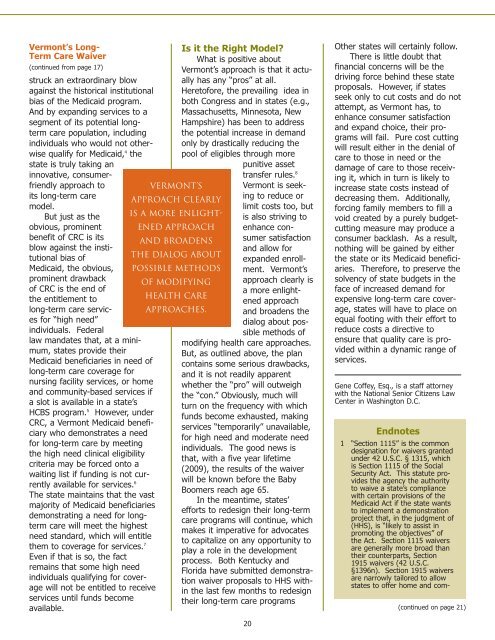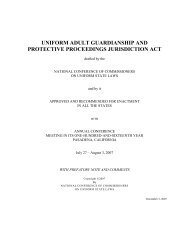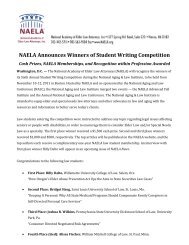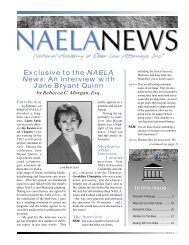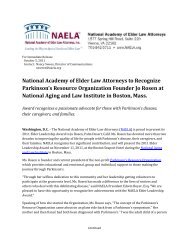N A E L A - National Academy of Elder Law Attorneys
N A E L A - National Academy of Elder Law Attorneys
N A E L A - National Academy of Elder Law Attorneys
You also want an ePaper? Increase the reach of your titles
YUMPU automatically turns print PDFs into web optimized ePapers that Google loves.
Vermont’s Long-<br />
Term Care Waiver<br />
(continued from page 17)<br />
struck an extraordinary blow<br />
against the historical institutional<br />
bias <strong>of</strong> the Medicaid program.<br />
And by expanding services to a<br />
segment <strong>of</strong> its potential longterm<br />
care population, including<br />
individuals who would not otherwise<br />
qualify for Medicaid, 4 the<br />
state is truly taking an<br />
innovative, consumerfriendly<br />
approach to<br />
its long-term care<br />
model.<br />
But just as the<br />
obvious, prominent<br />
benefit <strong>of</strong> CRC is its<br />
blow against the institutional<br />
bias <strong>of</strong><br />
Medicaid, the obvious,<br />
prominent drawback<br />
<strong>of</strong> CRC is the end <strong>of</strong><br />
the entitlement to<br />
long-term care services<br />
for “high need”<br />
individuals. Federal<br />
law mandates that, at a minimum,<br />
states provide their<br />
Medicaid beneficiaries in need <strong>of</strong><br />
long-term care coverage for<br />
nursing facility services, or home<br />
and community-based services if<br />
a slot is available in a state’s<br />
HCBS program. 5 However, under<br />
CRC, a Vermont Medicaid beneficiary<br />
who demonstrates a need<br />
for long-term care by meeting<br />
the high need clinical eligibility<br />
criteria may be forced onto a<br />
waiting list if funding is not currently<br />
available for services. 6<br />
The state maintains that the vast<br />
majority <strong>of</strong> Medicaid beneficiaries<br />
demonstrating a need for longterm<br />
care will meet the highest<br />
need standard, which will entitle<br />
them to coverage for services. 7<br />
Even if that is so, the fact<br />
remains that some high need<br />
individuals qualifying for coverage<br />
will not be entitled to receive<br />
services until funds become<br />
available.<br />
Vermont’s<br />
approach clearly<br />
is a more enlightened<br />
approach<br />
and broadens<br />
the dialog about<br />
possible methods<br />
<strong>of</strong> modifying<br />
health care<br />
approaches.<br />
Is it the Right Model?<br />
What is positive about<br />
Vermont’s approach is that it actually<br />
has any “pros” at all.<br />
Heret<strong>of</strong>ore, the prevailing idea in<br />
both Congress and in states (e.g.,<br />
Massachusetts, Minnesota, New<br />
Hampshire) has been to address<br />
the potential increase in demand<br />
only by drastically reducing the<br />
pool <strong>of</strong> eligibles through more<br />
punitive asset<br />
transfer rules. 8<br />
Vermont is seeking<br />
to reduce or<br />
limit costs too, but<br />
is also striving to<br />
enhance consumer<br />
satisfaction<br />
and allow for<br />
expanded enrollment.<br />
Vermont’s<br />
approach clearly is<br />
a more enlightened<br />
approach<br />
and broadens the<br />
dialog about possible<br />
methods <strong>of</strong><br />
modifying health care approaches.<br />
But, as outlined above, the plan<br />
contains some serious drawbacks,<br />
and it is not readily apparent<br />
whether the “pro” will outweigh<br />
the “con.” Obviously, much will<br />
turn on the frequency with which<br />
funds become exhausted, making<br />
services “temporarily” unavailable,<br />
for high need and moderate need<br />
individuals. The good news is<br />
that, with a five year lifetime<br />
(2009), the results <strong>of</strong> the waiver<br />
will be known before the Baby<br />
Boomers reach age 65.<br />
In the meantime, states’<br />
efforts to redesign their long-term<br />
care programs will continue, which<br />
makes it imperative for advocates<br />
to capitalize on any opportunity to<br />
play a role in the development<br />
process. Both Kentucky and<br />
Florida have submitted demonstration<br />
waiver proposals to HHS within<br />
the last few months to redesign<br />
their long-term care programs<br />
Other states will certainly follow.<br />
There is little doubt that<br />
financial concerns will be the<br />
driving force behind these state<br />
proposals. However, if states<br />
seek only to cut costs and do not<br />
attempt, as Vermont has, to<br />
enhance consumer satisfaction<br />
and expand choice, their programs<br />
will fail. Pure cost cutting<br />
will result either in the denial <strong>of</strong><br />
care to those in need or the<br />
damage <strong>of</strong> care to those receiving<br />
it, which in turn is likely to<br />
increase state costs instead <strong>of</strong><br />
decreasing them. Additionally,<br />
forcing family members to fill a<br />
void created by a purely budgetcutting<br />
measure may produce a<br />
consumer backlash. As a result,<br />
nothing will be gained by either<br />
the state or its Medicaid beneficiaries.<br />
Therefore, to preserve the<br />
solvency <strong>of</strong> state budgets in the<br />
face <strong>of</strong> increased demand for<br />
expensive long-term care coverage,<br />
states will have to place on<br />
equal footing with their effort to<br />
reduce costs a directive to<br />
ensure that quality care is provided<br />
within a dynamic range <strong>of</strong><br />
services.<br />
Gene C<strong>of</strong>fey, Esq., is a staff attorney<br />
with the <strong>National</strong> Senior Citizens <strong>Law</strong><br />
Center in Washington D.C.<br />
Endnotes<br />
1 “Section 1115” is the common<br />
designation for waivers granted<br />
under 42 U.S.C. § 1315, which<br />
is Section 1115 <strong>of</strong> the Social<br />
Security Act. This statute provides<br />
the agency the authority<br />
to waive a state’s compliance<br />
with certain provisions <strong>of</strong> the<br />
Medicaid Act if the state wants<br />
to implement a demonstration<br />
project that, in the judgment <strong>of</strong><br />
(HHS), is “likely to assist in<br />
promoting the objectives” <strong>of</strong><br />
the Act. Section 1115 waivers<br />
are generally more broad than<br />
their counterparts, Section<br />
1915 waivers (42 U.S.C.<br />
§1396n). Section 1915 waivers<br />
are narrowly tailored to allow<br />
states to <strong>of</strong>fer home and com-<br />
(continued on page 21)<br />
20


